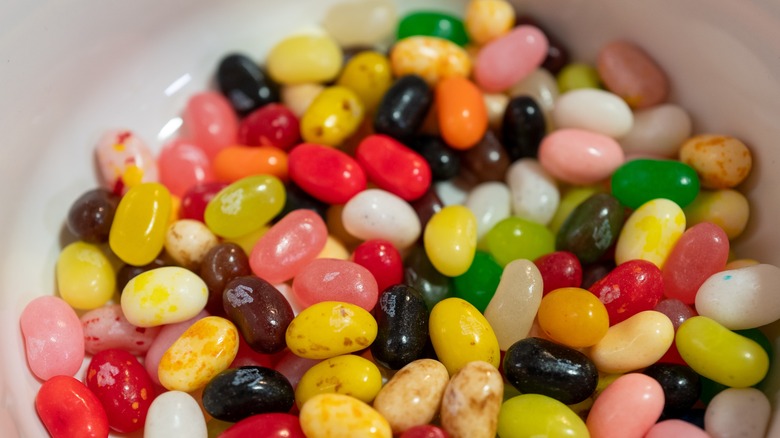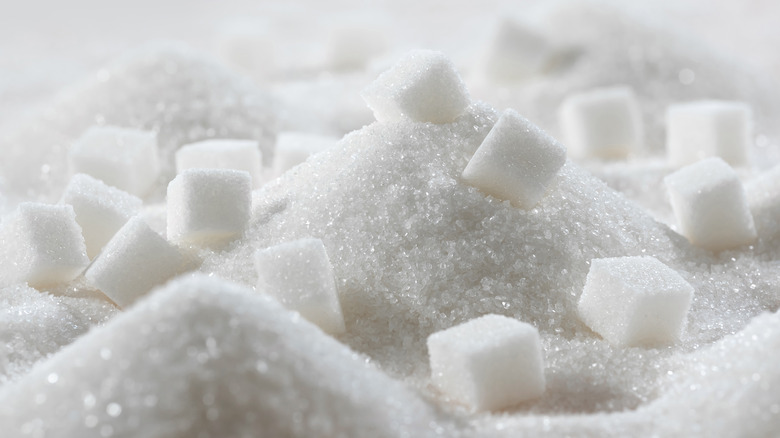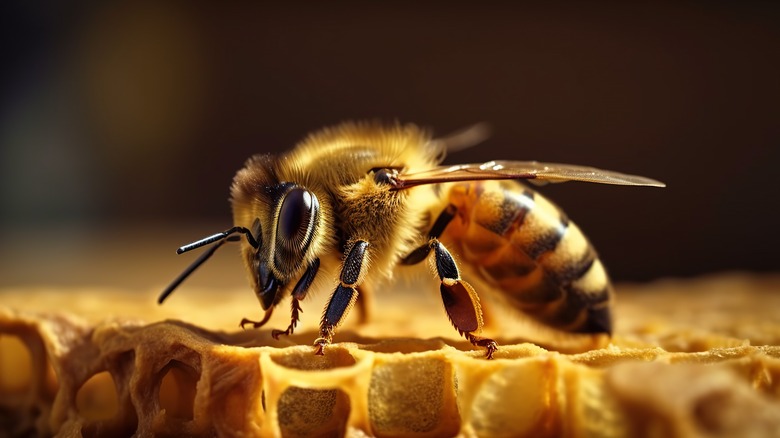Why You Need To Be Careful Eating Jelly Beans As A Vegan
Jelly beans are a delightful treat because almost everyone loves candy or needs that occasional hit of sweetness — even vegans. (And they're versatile, too — here are several things you didn't know you could do with jelly beans.) Due to a moral code or dietary restrictions, vegans will avoid eating food if even one of its ingredients is derived from an animal in some way. While obvious choices like chocolate (made with cows' milk) or honey-flavored treats are out, other candies may seem like they're safe for consumption by vegans, and fruit-flavored, mostly sugar jelly beans — on the surface — seem like a reasonable selection.
The ingredients list on a package of jelly beans may suggest that the candy inside is a simple combination of sugar, corn syrup, or both, along with some natural flavors, something to create a rainbow of appetizingly bright colors, a gelling agent to provide that certain bouncy squishiness, and probably a glaze to make the final product shiny and smooth. It's in these ingredients that vegans might run into trouble. Many major brands of jelly beans utilize ingredients that come from animals and insects — excluding certain candy from any list of vegan snack foods.
Animal products give jelly beans their sweetness and texture
Jelly beans would just be sugar and coloring without something in the mix to make those tiny candies chewy, gelatinous, and jelly-like. Some manufacturers utilize tapioca for this purpose, and as that's a plant it falls under the purview of a vegan diet. Tapioca, pectin, and corn syrup can also provide that jelly bean consistency, and those ingredients are all plant-based, too. But if jelly beans contain gelatin, then the candy isn't appropriate for vegans. Gelatin is an animal collagen procured by boiling pigs' and cows' tendons, ligaments, skin, and bones. It's thick and viscous and gives jelly beans their shape. But as it's also almost meat, it's unacceptable on a vegan meal plan.
The sugar in jelly beans — or even the sugar you put in your coffee — is also likely not conducive to a vegan diet. To get raw, unprocessed sugar to a plate where its grains are smooth and uniform, and everything is gleaming white, producers filter it. Historically, the filter used is bone char, a kind of charcoal derived from the burning of animal bones. Traces remain in the sugar, making that otherwise plant-based food not strictly vegan.
The glaze on jelly beans often comes from animals
Food processors might use plant-originated, food-safe dyes and lacquers to ensure their jelly beans come in a rainbow of appetizingly bright colors. But vegans should beware — those jelly beans might also get their charming appearance from naturally-occurring ingredients made by, or out of insects. Bugs are living, breathing things, and vegans won't eat stuff that involves their bodies or their labor.
Not only do bees make honey with their bodies, they naturally produce beeswax, too. They eat honey, and their wax-making glands convert the natural sugars in honey into wax, which they push out of their pores. That's collected by humans for several industrial purposes, such as making food glazes, the kind that makes jelly beans shine. Another insect secretion is included in candy-making: shellac. It's a resin made inside of the female lac bug. Another frequently used shining agent in jelly beans is confectioner's glaze. That sounds innocuous, as it's reminiscent of confectioner's sugar. But while sugar can be vegan-safe, confectioner's glaze isn't. That's a euphemistic name to disguise the fact that confectioner's glaze is just shellac.
So, if you're a vigilant vegan, make sure to check the jelly bean packet for a detailed ingredient list, or be prepared to do your research about the ingredients the candy company favors.


